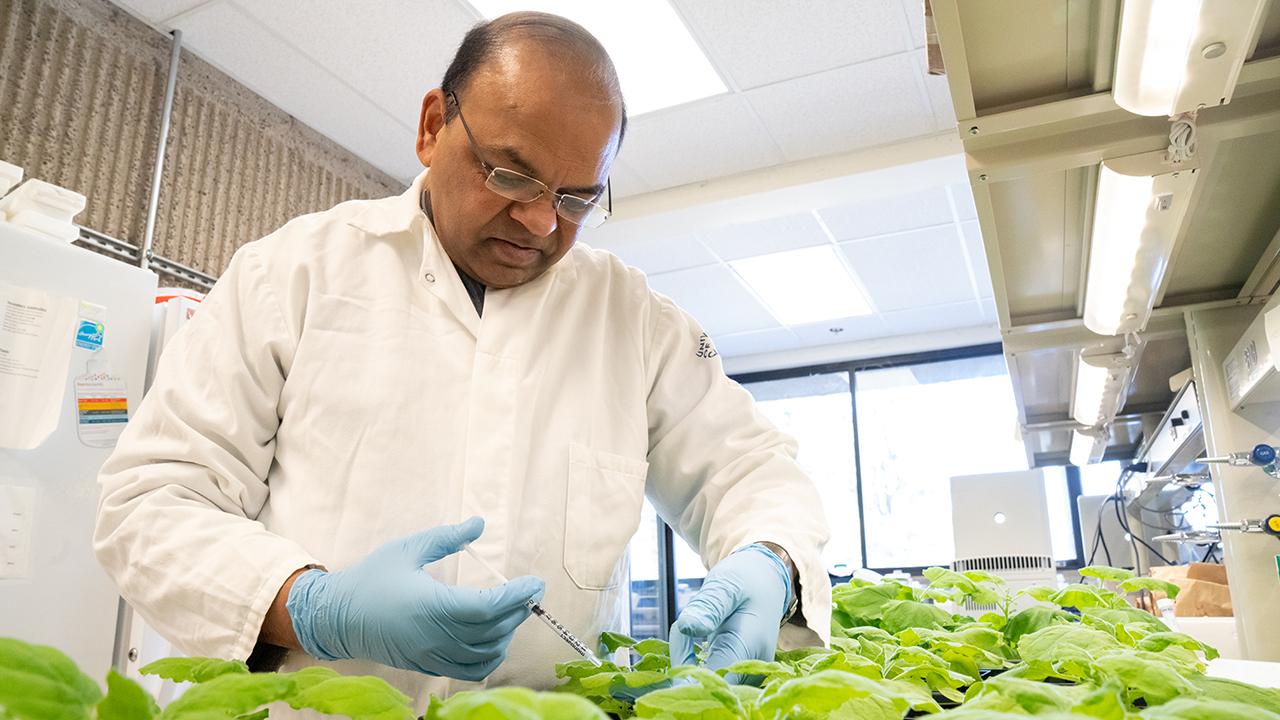
Plant Biologists Identify Promising New Fungicides
A promising new fungicide to fight devastating crop diseases has been identified by researchers at the University of California, Davis. The chemical, ebselen, prevented fungal infections in apples, grapes, strawberries, tomatoes and roses, and improved symptoms of pre-existing fungal infection in rice.
Fungal pathogens account for almost a quarter of global crop losses—in the US, these losses amount to around $150 billion per year. However, fungicide development has been slow for the past 50 years, largely because researchers have had difficulty identifying molecular pathways to target. In a new study published Feb. 29 in Nature Communications, UC Davis researchers identified fungicide candidates that target autophagy, a cellular recycling process that was recently shown to be essential for fungal pathogenicity.
Using a novel screening method based on bioluminescence, the researchers identified 30 chemicals that inhibit a key enzymatic step in fungal autophagy. The most promising candidate, a chemical called ebselen that has been shown to have anti-inflammatory and neuroprotective properties in humans, was more effective at preventing in vitro fungal growth than currently available fungicides.
“Inhibiting autophagy significantly reduces the pathogenicity of several devastating fungal pathogens,” said senior author Savithramma Dinesh-Kumar, a professor and chair in the Department of Plant Biology. “Our findings provide molecular insights that will help to develop the next generation of antifungal compounds.”
A novel fungicide target
Autophagy is an essential process in fungi, plants and animal cells that enables them to recycle cellular components and remove toxic waste products. Because recent studies have shown that autophagy is involved in fungal pathogenicity, the researchers hypothesized that blocking autophagy would inhibit fungal infection. They set out to identify chemicals that inhibit autophagy in fungi, focusing on one key step in the pathway—the enzymatic cleavage of the ATG8 protein by the enzyme ATG4.

To identify chemicals that inhibit this cleavage reaction, the team developed a test that allowed them to visualize when the reaction occurred and when it was blocked by using bioluminescent and fluorescent markers. Then, they tested the fungi’s ability to enzymatically cleave ATG8 in the presence of 2,700 different chemicals from a library of FDA approved compounds. This method has advantages over other screening methods in that it allows a large number of chemicals to be tested very rapidly. Altogether, the researchers identified 30 chemical compounds that inhibited cleavage and 14 compounds that enhanced cleavage. They selected the most effective inhibitor, ebselen, for further testing.
Protecting and curing plants from fungal pathogens
In petri-dish experiments, ebselen prevented fungal germination and growth “better than existing drugs that are on the market right now,” said Dinesh-Kumar. The team also showed that ebselen prevented fungal infections in a range of plant species and also demonstrated curative potential: when the researchers applied the chemical to the leaves of rice plants that were previously infected with rice blast fungus (Magnaporthe oryzae), it effectively eliminated infection.
“We think ebselen will primarily be useful for protecting plants against future infections, but it can also partially overcome existing infections if it is used early enough,” said Dinesh-Kumar.
Although the team’s preliminary testing indicates that ebselen specifically inhibits autophagy in fungi, more testing is needed to ensure its safety. “Since autophagy is highly conserved across different organisms, including humans, more work needs to be done to test the cross reactivity of the drug,” said Dinesh-Kumar.
They also plan to use their screening method to test even more chemicals for their ability to inhibit autophagy. “The chemical space is very large, and some chemical libraries have more than 50,000 compounds,” said Dinesh-Kumar. “The next step will be to screen for additional autophagy modulators that might help control not just plant fungal pathogens, but also human fungal pathogens.”
Additional authors on the study are: Tatiana V. Roubtsova, Celine Caseys, Dan Kliebenstein, and Richard M. Bostock, UC Davis; Jongchan Woo, Seungmee Jung, and Eunsook Park, University of Wyoming, Laramie; Martin B. Dickman, Honghong Zhang, and Yurong Li, Texas A & M University; Kyung-Nam Kim, Sejong University, Korea; and Seongbeom Kim, Hyunjung Chung, Yong-Hwan Lee and Doil Choi, Seoul National University, Korea.
The work was supported by the National Science Foundation, the Korea National Research Foundation, and the National Institutes of Health.
Media Resources
- Read the paper (Nature Communications)
- Savithramma Dinesh-Kumar, Plant Biology, spdineshkumar@ucdavis.edu
- Andy Fell, News and Media Relations, 530-304-8888, ahfell@ucdavis.edu
- Liana Wait is a freelance science writer based in Philadelphia. She has a Ph.D. in ecology and evolutionary biology and specializes in writing about the life sciences.
